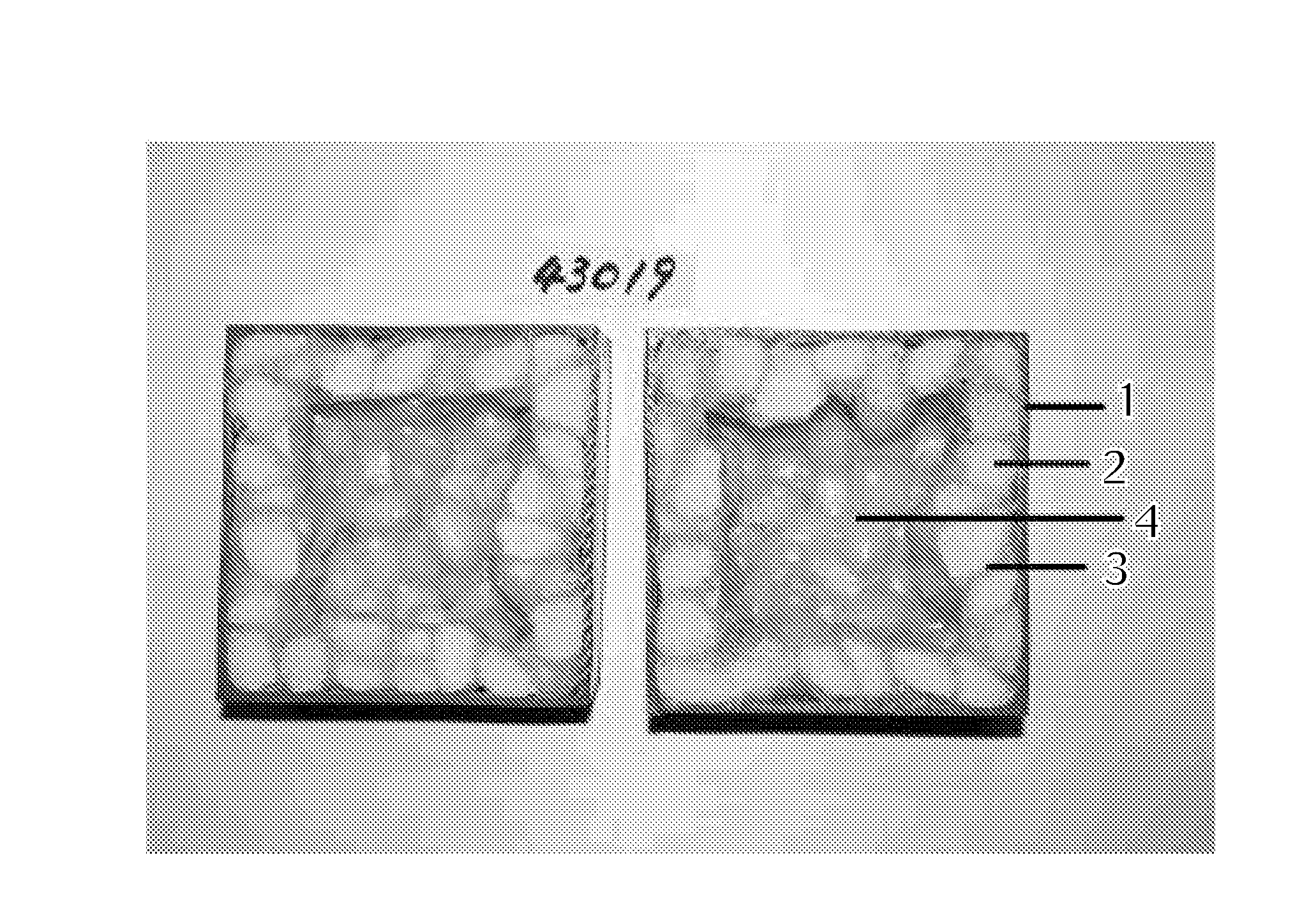Process for producing plastic foam composite
a technology of plastic foam and composites, which is applied in the direction of closures using stoppers, liquid handling, transportation and packaging, etc., can solve the problems of insufficient use of plastic bodies, insufficient production of lightweight shaped bodies with strength, and inability to obtain insulation materials that absorb almost no moisture, etc., to achieve strong shaped bodies, improve compression strength, and reduce the effect of core strength
- Summary
- Abstract
- Description
- Claims
- Application Information
AI Technical Summary
Benefits of technology
Problems solved by technology
Method used
Image
Examples
example 1
[0080]58 g of HDPE powder (i.e. a main peak of the particle size distribution at 0.1 mm) with a density of 0.96 g / cm3 and a melt property of 1×104 Pa, characterized by storage elastic modulus measured at 190° C. and at the angular velocity 1 rad / s, and 10 g of pellets, formed by mixing 0.1, 0.3, 0.5, 0.7, or 0.9 PHR of dicumyl peroxide with LDPE having a density of 0.92 g / cm3 and a MFR of 1.5 g / 10 min, and by mixing to each mixtures 20 PHR of azodicarbonamide and 0.5 PHR of trimethylolpropane triacrylate and kneading, and then conducting processing to form pellets having the length of a side 4 mm, were charged in a steel mold with internal dimensions of 100×100×25 mm and a wall thickness of 4 mm. The mold was then mounted to an electrically heated swinging-rotating type molding apparatus, foaming was conducted applying a main rotational speed of 10 rpm and a secondary rotational speed of 5 rpm, and heating at the ambient temperature inside of the apparatus of 230° C. for 25 min, and...
example 2
[0083]0.5 PHR of Perkadox™ (i.e. bis-(4-t-butylcyclohexyl)peroxidicarbonate) and 20 PHR of ADCA (i.e. azodicarbonamide) were mixed with LDPE with a MFR of 1.5 g / 10 min., and the mixture was shaped into a rod of 4 mm in diameter, and then the rod was provided with a 2 mm thick covering of HDPE having a MFR of 3.0 g / 10 min., compressed and cut in the molten state into 8 mm long, consequently double-layered pellets, whole surfaces of which were covered with the plastic layer, were obtained. The minimum thickness of the joined section was 0.6 mm. The double-layered pellets were charged in four molds with internal dimensions of 100×100×25 mm, together with 58 g of HDPE powders having a MFR of 1 g / 10 min., while the quantity of the double-layered pellets was varied between 17.7, 14.3, 12.1, and 9.6 g for each mold, and then molding of a foam composite was conducted using a main rotational speed of 10 rpm, a secondary rotational speed of 5 rpm, and a heating at 230 for 30 minutes, and foll...
example 3
[0085]Using HDPE powders with a MFR of 1 g / 10 min., and the same 4 mm long rod as that shaped in the example 2, but the rod was provided with a 2 mm thick covering of LDPE having a MFR of 1.5 g / 10 min., and was cut into 8 mm long, and thus obtained double-layered pellets were charged in a mold with internal dimensions of 100×100×25 mm, and then molding of a foam composite was conducted using a main rotational speed of 10 rpm and a secondary rotational speed of 5 rpm, and a heating to foam at 230° C. for 30 minutes, and following cooling in water for 30 minutes. Thus obtained foamed body was like that in FIG. 3, having a skin with an even thickness, low-density foamed bodies, and belt-, string-shape, or solid reinforcing bodies in a mingled state. The half part to the left of the foam has been removed for convenience to observe the shape of reinforcing members, as is the photograph of the foam composite in FIG. 3, and it was clarified that the reinforcing members make an aggregate of...
PUM
| Property | Measurement | Unit |
|---|---|---|
| thickness | aaaaa | aaaaa |
| density | aaaaa | aaaaa |
| thickness | aaaaa | aaaaa |
Abstract
Description
Claims
Application Information
 Login to View More
Login to View More - R&D
- Intellectual Property
- Life Sciences
- Materials
- Tech Scout
- Unparalleled Data Quality
- Higher Quality Content
- 60% Fewer Hallucinations
Browse by: Latest US Patents, China's latest patents, Technical Efficacy Thesaurus, Application Domain, Technology Topic, Popular Technical Reports.
© 2025 PatSnap. All rights reserved.Legal|Privacy policy|Modern Slavery Act Transparency Statement|Sitemap|About US| Contact US: help@patsnap.com



